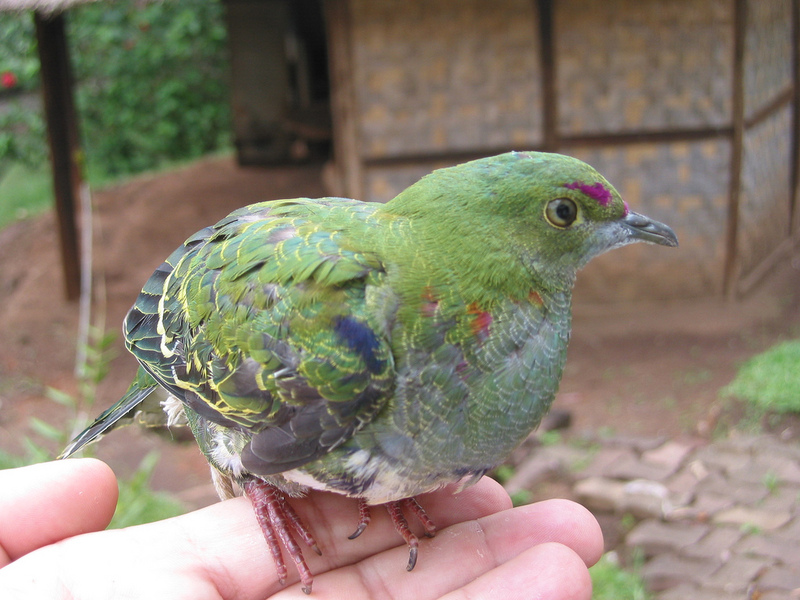|
| 질의: Orange fruit dove | 결과: 13번째/39 | |
Superb Fruit-dove (Ptilinopus superbus) - Wiki
| 제목: | Superb Fruit-dove (Ptilinopus superbus) - Wiki
| |

| 해상도: 1024x768
파일크기: 365404 Bytes
등록시간: 2007:12:20 11:42:06
|
Superb Fruit-dove
From Wikipedia, the free encyclopedia
Order: Columbiformes
Family: Columbidae
[Photo] Superb fruit dove with a woven-bamboo, wood, and grass house in the background. A bird in the hand is easier to photograph than two in the bush. This photo was taken in Ukarumpa, Eastern Highlands Province, Papua New Guinea. 2006-03-04-13-34-49-Soccer-Bird-Rachel67. Source: Flickr (www.flickr.com/photos/kahunapulej/322503931/). Date: March 4, 2006. Author: kahunapulej (www.flickr.com/photos/kahunapulej/).
The Superb Fruit-dove (Ptilinopus superbus), also known as the Purple-crowned Fruit-dove, is a medium-sized (22-24 cm long), colourful fruit-dove in the family Columbidae.
Range
Native to Australasia, the Superb Fruit-dove lives in the rainforests of New Guinea, Australia, Solomon Islands, the Philippines and Sulawesi of Indonesia. In Australia, it is found from southern Victoria further north, where it becomes more common to Cape York in Queensland. In some areas of its range, such as the New Guinean rainforest, it is a resident bird; in more marginal or seasonal habitats such as those in Australia, flocks are known to move about according to the availability of food (Frith et al. 1976).
Description
Sexes are sexually dimorphic. Males are superbly coloured with a fiery orange nape, green ears, and a purple crown. The breast is grey, and divided from the abdomen by a wide, dark blue band. Their wings are olive green covered with dark spots, and the tail is tipped with white. Females are mostly green, with a white abdomen, blue wing tips, light blue breast, and a small, dark blue spot on the back of the head. Both sexes have yellow eyes and eye-rings. Despite its colourful plumage, the Superb Fruit-dove is well-camouflaged amongst the rainforest foliage.
Diet
The Superb Fruit-dove feeds primarily upon fruits and berries. In the Port Moresby area, the bulk of its diet was found to consist of figs, notably Ficus albipila and Ficus benjamina, Canarium australianum drupes, and Archontophoenix, Calamus and Livistona palm fruit. Also frequently eaten were the fruits of various cinnamon trees, Litsea, Neolitsea and Cryptocarya. Less important food were fruits of Ylang-ylang (Cananga odorata), Syzygium, and Vitex cofassus. They eat smaller fruit than some other fruit doves; the maximum recorded volume was 2.5 cm³; in a spherical fruit, a 1.7 cm diameter.
Behavior
Superb Fruit-doves' wings whistle when they fly, and their call is a steady coo-coo-coo-coo.
The breeding season lasts from September to January. A small platform of twigs is built 5-30 metres off the ground, in which the female lays one small, white egg. She incubates it during the day. The male takes his turn during the night.
Conservation
Habitat loss is a primary threat, but the Superb Fruit-dove is still fairly widespread and common throughout its large range. The IUCN Red List of Threatened Species ranks it as least concern. In New South Wales, however, the Superb Fruit-dove is considered vulnerable, meaning it is likely to become endangered.
http://en.wikipedia.org/wiki/Superb_Fruit-dove
| The text in this page is based on the copyrighted Wikipedia article shown in above URL. It is used under the GNU Free Documentation License. You may redistribute it, verbatim or modified, providing that you comply with the terms of the GFDL. |
|
댓글 |
|---|
| | 손님 |
|
Scientific Name: Ptilinopus superbus (Temminck, 1809)
Common Names:
English – Eastern Superb Fruit-dove, Superb Fruit Dove, Superb Fruit-dove, Superb Fruit-Dove
French: Ptilope superbe German: Östliche Prachtfruchttaube Spanish: Tilopo soberbio oriental
Taxonomy: Columba Superba Temminck, 1809, Halmahera. |
^o^
동물그림창고 똑똑전화 누리집
^o^
|
|
|